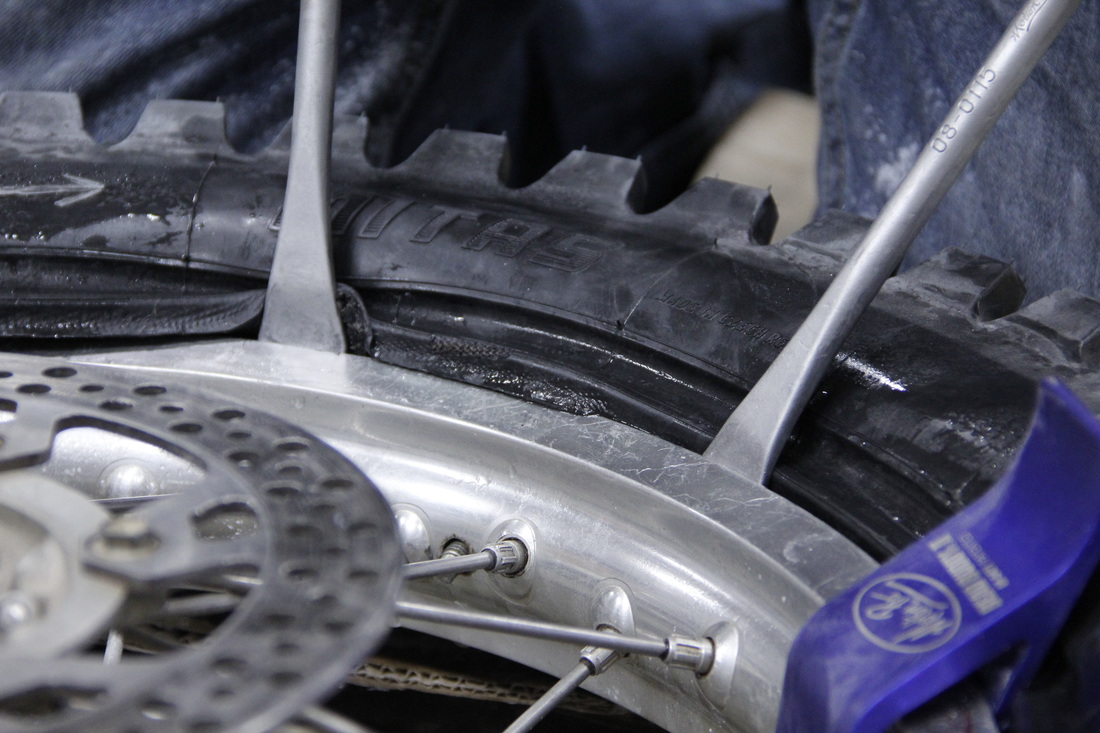To best illustrate the mounting process, studding process (next week’s post), and all the knowledge Jarrett shared in our previous post, I’ll be preparing a new set of tires. Jarrett will continue to chime in with (much needed) guidance and commentary. We’ll get into more detail on why things are done in a specific way, and share examples of tire builds that you can use as a reference.
My first set of ice tires was a Bridgestone front and Kenda rear combo built by Jeff Fredette. I liked the Bridgestone front, but have had some trouble maintaining traction with the Kenda rear on anything but clean ice. I decided this year that I wanted to try something new and after talking with Jarrett, I was sold on the Mitas Ice Kings. Full disclosure, I am not an affiliate of Mitas Ice King Tires, I just love their product. To me, the Mitas ice tires are advantageous for a number of reasons. First, they were designed for the ice and have a rubber compound that was specifically made for cold weather riding. Second, the tires don’t require any internal tire liners, which simplifies the mounting process and may save a little weight. Third, the tread pattern was designed to work in conditions where the ice isn’t perfectly clean. Finally, since the tires were designed knowing that screws would be installed, the tires are also more tolerant of being screwed into. This results in a longer lasting tire. Needless to say, the following walkthroughs on mounting and studding will feature a set of the Mitas Ice Kings
Paul: Ice tires are inherently more difficult to mount than normal MX tires due to their thickness, stiffness, and extra liners (if any are used). I’ve always hated mounting tires and have never been great at it, so every year when it is time to mount my ice tires I’ve always despised the task. Jarrett compiled a list of awesome tips that I applied as I mounted my new tires this year. Some of his tips I’ve been doing for years and some were completely new to me. Regardless, his pointers are great reminders for everyone and the new info Jarrett provided made the job so much easier.
Paul: The tires I’ll be mounting are the Mitas Ice Kings. These tires are very thick and were designed to be studded after they have been mounted. Some tires which require a liner (pretty much everything other than a Mitas) will need to be studded before they are mounted. Studding lined tires before mounting is important to ensure the liner is situated inside the tire correctly and that all the screws have found their way into the liner and won’t puncture the tube.
What You Will Need
- 2 -3 tire irons
- Bead Buddy
- Tire Tamer
- 4 - 5 wrenches
- Soapy water in a spray bottle
- Baby powder
- Tube Snake (Optional)
Paul: I’m going to start at the beginning with the tire completely off the rim. A lot of Jarrett’s knowledge comes into play once the tire is halfway on, at which point he’ll chime in with many pointers.
I’ve already checked my rim for trueness, felt for sharp spots, and installed a new rim strip so I know it’s good to go. If you haven’t, you should definitely complete these steps before going through the trouble of mounting the tires.
Paul: The first order of business is to get half the tire over the rim. The Rear Mitas Ice King must be mounted backwards from the prescribed directional arrows.
Next, flip the tire and rim over so that the sprocket faces down.
Paul: Thanks to Jarrett I just started incorporating this trick and it makes a world of difference!
Paul: This is an awesome tip that I’ve used in the past with great success. Temporarily inflate the tire so that it is easier to apply the powder. Then coat the tube with powder and disperse it evenly by rubbing the tube.
Paul: After speaking with Jarrett I bought a tire tamer specifically for this project. It has been one of the best additions to my toolbox I’ve made. Simply pry the side of the tire up and work the tube evenly into the tire. No more bloody knuckles!
As you work the tube into the tire, make sure the tube lays flat and doesn’t twist.
Paul: Before the remaining bead is pulled over the rim, pull the tire up near the rim lock and make sure the the tube isn’t pinched between the rim lock and rim.
It is now time to pry the remaining bead over the rim. Before I get started I want to allow Jarrett to chime in and provide a couple of pointers.
Jarrett:
- Always use tons of soap/water lubricant on the tire.
- Be sure to take small pulls with the tire irons. As soon as you feel like it takes a really big pull something is wrong and it is time to make tweaks to the setup.
- Once the tube has been installed start to the left of the rim lock.
Paul: In the picture below I’ve inserted two tire irons just to the left of the rim lock and am spraying the tire with lube in preparation for prying the bead over the rim.
Paul: The method Jarrett prescribed is by far the best I’ve used for mounting ice tires and made my life a lot easier. Inserting the wrenches as you work to keep the bead down in the drop center is definitely key.
Once the valve core has been reinstalled after the quick burst, I’ll inflate the tire to full pressure and seat the bead against the rim.
With any luck you should have an ice tire that is ready to be studded!







































